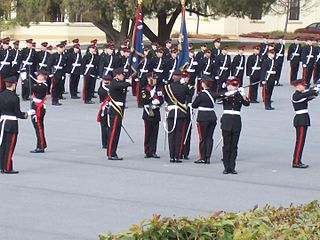
A military academy or service academy is an educational institution which prepares candidates for service in the officer corps. It normally provides education in a military environment, the exact definition depending on the country concerned.

The United States Air Force Academy (USAFA) is a United States service academy in El Paso County, Colorado, immediately north of Colorado Springs. It educates cadets for service in the officer corps of the United States Air Force and United States Space Force. It is the youngest of the five service academies, having graduated its first class 65 years ago in 1959, but is the third in seniority. Graduates of the academy's four-year program receive a Bachelor of Science degree and are commissioned as second lieutenants in the U.S. Air Force or U.S. Space Force. The academy is also one of the largest tourist attractions in Colorado, attracting approximately a million visitors each year.

A non-commissioned officer (NCO) is a military officer who does not hold a commission. Non-commissioned officers usually earn their position of authority by promotion through the enlisted ranks. In contrast, commissioned officers usually enter directly from a military academy, officer training corps (OTC) or reserve officer training corps (ROTC), or officer candidate school (OCS) or officer training school (OTS), after receiving a post-secondary degree.
Corporal is a military rank in use by the armed forces of many countries. It is also a police rank in some police services. The rank is usually the lowest ranking non-commissioned officer. In some militaries, the rank of corporal nominally corresponds to commanding a section or squad of soldiers.

The Texas A&M University Corps of Cadets is a student military organization at Texas A&M University. Established with the university in 1876, it is the oldest student organization on campus.
A cadet is a student or trainee, and is typically used in military settings to denote an individual undergoing training to become commissioned officers. Several civilian organisations, including civil aviation groups, maritime organisations, and police services, also designate their trainees as cadets.
Officer Cadet is a rank held by military cadets during their training to become commissioned officers. In the United Kingdom, the rank is also used by members of University Royal Naval Units, University Officer Training Corps and University Air Squadron; however, these are not trainee officers with many not choosing a career in the armed forces.

The Air Force Reserve Officers' Training Corps (AFROTC) is one of the three primary commissioning sources for officers in the United States Air Force and United States Space Force, the other two being the United States Air Force Academy (USAFA) and Air Force Officer Training School (OTS). A subordinate command of the Air University within the Air Education and Training Command (AETC), AFROTC is aligned under the Jeanne M. Holm Center for Officer Accessions and Citizen Development at Maxwell AFB, Alabama. The Holm Center, formerly known as the Air Force Officer Accession and Training Schools (AFOATS), retains direct responsibility for both AFROTC and OTS.
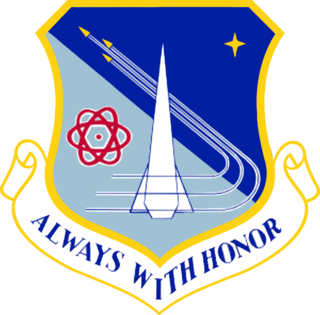
Officer Training School (OTS) is a United States Air Force and United States Space Force commissioning program located at Maxwell Air Force Base in Montgomery, Alabama.

AdisutjiptoAirport is an airport serving the Yogyakarta area on the island of Java, Indonesia. It was formerly the principal international airport serving this area. The airport is located in the Sleman Regency, in the Yogyakarta Special Region, on the northeast outskirts of the city, near the Prambanan historic temple site. The airport is approximately 6 kilometres (3.7 mi) from the city centre.
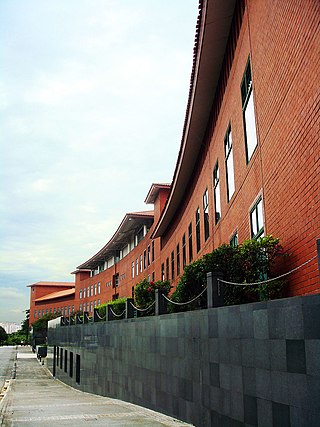
The Officer Cadet School (OCS) is a military training centre that trains commissioned officers for the four branches of the Singapore Armed Forces (SAF): the Army, the Navy, the Air Force, and the Digital and Intelligence Service.
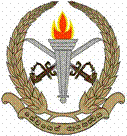
The Sri Lanka Military Academy, commonly known simply as Diyatalawa, is the oldest military academy in Sri Lanka, and trains commissioned officers for the Sri Lanka Army. It is located in the garrison town of Diyatalawa in the central highlands of Sri Lanka. It has capacity to train more than 300 cadets.
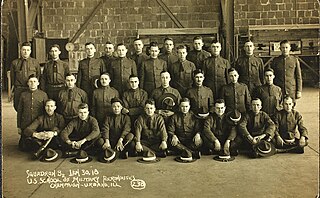
The Flying/Aviation Cadet Pilot Training Program was originally created by the U.S. Army to train its pilots. Originally created in 1907 by the U.S. Army Signal Corps, it expanded as the Army's air assets increased.
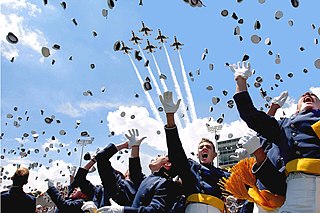
The United States Air Force Academy Cadet Wing (AFCW) is the student body of the United States Air Force Academy. The students, called "cadets", are divided into four classes, based on their year in school, much like a civilian college. They are not called freshmen, sophomores, juniors and seniors, however, but fourth-, third-, second- and first-class cadets, respectively. Fourth-class cadets (freshmen) are sometimes called "doolies", a term derived from the Greek word δοῦλος ("doulos") meaning "slave" or "servant." Members of the three lower classes are also called "4 degrees", "3 degrees" or "2 degrees" (or "4-degs", 3-degs", and "2-degs" respectively) based on their class. First-class cadets (seniors) are called "firsties". In the military structure of the Cadet Wing, first class cadets hold the positions of cadet officers, second class cadets act as the cadet non-commissioned officers and third-class cadets represent the cadet junior non-commissioned officers.

Agustinus Adisutjipto was born in Salatiga, Central Java, and raised as a Roman Catholic. He was the first pilot of the Indonesian Air Force, whose plane was shot down by the Dutch during the Indonesian National Revolution. He was posthumously declared a National Hero of Indonesia in 1974.

The Brazilian Air Force Academy is the Brazilian Air Force's educational institution that provides initial officer training for the main Officer Board of Brazil's Air Force Command. The academy is located east of Pirassununga city, in São Paulo State county, and it is the largest Brazilian Air Base as well as the largest Air Force Academy of Latin America. All three Officer Formation Courses (CFOs) of Academia da Força Aérea are recognized as Superior Degree by Brazil's Ministry of Educations.
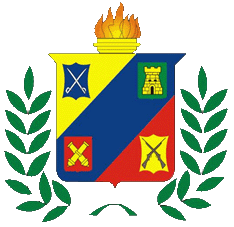
The Military Academy of the Bolivarian Army, previously called Military Academy of Venezuela, is an academy to train members of the officer corps of the National Army of the Bolivarian Republic of Venezuela, attached to Bolivarian Military University of Venezuela. It is also the oldest military academy in the country and one of the oldest in Latin America, having been founded on September 2, 1810.

The Military Academy is a service academy of the Indonesian Army, part of the Indonesian National Armed Forces Academy. Founded on the early stages of the Indonesian Revolutionary War and located in the city of Magelang in Central Java, its alumni form a professional officer corps for the army, with all Indonesian Army Chiefs of Staff since 1988 having graduated from Akmil.

The Naval Academy is a service academy of the Indonesian Navy, the naval component of the Indonesian National Armed Forces Academy System or the AKABRI. Its campus is located in Surabaya, East Java and trains men and women to become officers of the Navy, including the Indonesian Marine Corps, Fleet Forces, Naval Aviation and support branches.

Air Chief Marshal (Ret.) Elang Soerjadi Soerjadarma was the Commander of the Indonesian National Armed Forces from 1959 to 1962 and the Chief of Staff of the Indonesian Air Force from 1946 to 1962.


















